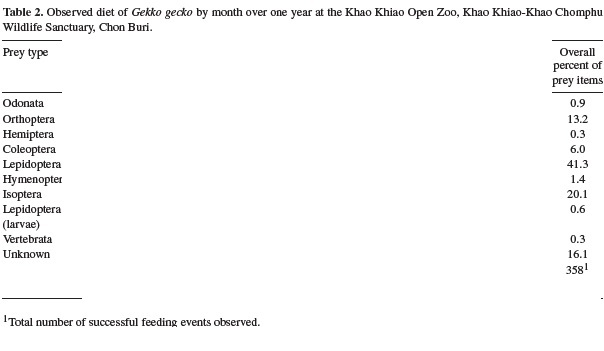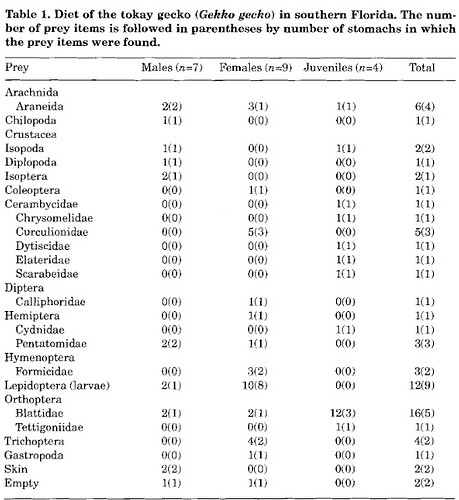I think that bigger tokays especially breeder females and big males should eat 2-3 pinkies a week to every two weeks. I want everyone’s thoughts.
My thoughts are you will most likely end up with some obese and unhealthy tokays. I wouldn’t feed them more than once a month
No where in their native range are they going to be finding pinkies on any kind of regular basis (if at all)
They are, first and foremost, insectivores. Larger animals should be feed more and/or larger gut-loaded and supplemented insects, not consistently provided with fatty mammalian prey that they are not evolved to process
First off they aren’t insectivores they are opportunistic feeders. Meaning they will eat everything that they can get their mouths around. They eat very hard protein prey items all the time. That includes birds, snakes, other lizards and in many cases rodents.
Tokays need that extra fat however because they have such a high energy expenditure. I feed tokays pinkies and fuzzies a lot. With my proper cage size and things to do I have never had or seen an overweight tokay (with the proper enclosure size and enrichment opportunities).
That isn’t how it works. Yes, they are more active than a lot of other reptiles but that doesn’t mean that you should feed them something that their bodies aren’t meant to be eating. What you should be doing is just feeding more insects.
I don’t agree. Once/twice a month as a treat yeah sure but that’s it, tokays in captivity are primarily fed insects. And even then I’ve seen some obese over fed ones. But They don’t get the space like in the wild to run miles if they’d like too to work fat off. So I think bugs are just fine.
…
Well by that logic, since they are so opportunistic and will eat everything, I guess you should start feeding butter and TacoBell as well
/s
Just because you can feed them something they are NOT evolved to eat does not mean you should
.
.
.
It has not one thing to do with protein. I very clearly said:
Opportunistic is not a type of diet. And yes, they are insectivores.
In the wild, they do what they have to to stay alive. In the wild staying alive comes before what is healthy for them. Just because in the wild they will eat other animals if they are unable to find other food doesn’t mean that they should be in captivity. And as has been mentioned multiple times, just because they will eat it doesn’t mean they should.
First off protein is worse than fat in captivity in every degree. You want a fat base diet so they can burn it off easy. And the butter and taco bell please go out to to their native lands and find that stuff running around. Anyways there is A LOT of nest to be raided in trees and on the ground which my gecko raids daily. In fact here is a tokay that is fed 2-3 pinkies and fuzzies per week. Very healthy active and most importantly not overweight. If you do a little research on inaturalist combined with other sites look at what they eat in the wild and how much of that and tell me that my gecko is unhealthy or is being taken care of improperly. Also look into dietician and see that protein is a lot more harmful on a body that can’t exercise properly rather than fat.
h
They are meant to be eating that though. They come across EVERYTHING in the wild. Including snakes!! These guys should be fed a hard item diet. Not saying to completely get off of bugs. However quail, chicken, pinkies, fuzzies should be offered regularly. That is what they find in the wild not really chicken or quail exactly but there great substitutes for their native birds. I offer mine pinkies and fuzzies regularly in a great size cage with nests and mine is doing amazing.
I agree with you on seeing the overweight ones. However a properly taken care of tokay should be easy to burn fat off. Mine burns it off in two days or less. And it’s natural for them to eat hard prey items. These guys are ruthless predators. Have you seen them pick birds out from the sky? It’s a marvelous thing to watch but mine and all my tokays are extremely healthy and look WAY better than before. They have brighter eyes, have better looking colors, are WAY more active.
Okay I made this account specifically to debate here. Let’s break down what we know about tokay geckos.
First off, there is no research done on the digestive processes/make up that has been published and peer reviewed on a wide scale for Tokay geckos. Almost all research done on Tokays is speculative in nature and would need much deeper review to make claims like “they are not designed to eat mammalian protein”. So at this point that is an opinion. Which your entitled too, but I disagree with it respectfully.
So where do Tokays come from? Tokays have a GINORMOUS range including south eastern asian, Malaysia, and even the Philippines.
My step mother is filipino and has told me many stories of Tokays eating bats, house mice, birds, and bugs. Some Filipino people even keep them in the house/garage for this reason. She has a photo of well over 15 hanging out on the wall in the garage lol.
Secondly, there are plenty of videos available online of tokay geckos killing and eating some pretty wild things. I saw one video of a Tokay gecko tearing apart a 6 foot snake.
Thirdly, bats are frequent prey items of Tokay geckos, bats are also mammals.
Fourth and foremost, most people on this website could not even accurately describe the environment that these animals come from, let alone be an authority on what they eat in the wild. Open the spectrum of what you may know about an animal. Be willing to think outside of the box and learn new things.
Like what does eating a bat mean? Bats are largely insectivores and they eat ALOT of bugs, so if an animal eats the bat; then it’s also eating bugs. Let’s dig further than that, what do many flying insects that bats eat spend their time collecting? Pollen, Anything that eats the insect now eats pollen. So now anything that eats, the bat is now eating a mammal, insects, and flower pollen. These animals have evolved to eat a wide variety of prey items, including mammalian protein. Feeding pinkies to the tokays is not unhealthy within control, offering things like a nest to raid can be enriching for the Gecko and promote healthier and more naturalistic behaviors.
Anyways, that is my rant. Just some food for thought.
Refer to my post above. For most of this.
I completely agree with this but I personally don’t think feeding 2-3 pinkies a week falls into “within control”.
And in the in the wild they can roam for miles looking for their next meal. In captivity they can move around what, a 2x2x2 box with their next meals being brought to them every other day?
I knew this was coming ![]()
Do me a favour and go out in their habitat and find me domestic pinky mice running around
.
.
.
You have not even done the research you challenge me to do
From two entirely different peer reviewed studies that took me mere moments to locate

Notice the very distinct and clear data showing the LACK that mammals of any type make in their diet
.
.
.
I am already very aware of how protein can damage a body. I can also state absolutely that the inside of a cage is not even remotely close to an environment where these animals can “exercise properly”. Further, I have seen far more animals in this hobby dead from obesity than from gout
.
.
.
Disagree with me as respectively as you wish. I will point you directly above as well. Peer-reviewed published data showing exactly what you claim does not exist
I will take it one step further and reduce it to the most relevant info

0.3% of total diet from 358 independent observed successful feeding events were from some type of Vertebrata
Let us pick that apart a bit, shall we? Back of envelope style for simplicity:
0.3% of 358 is 1.074, so we will call that 1.
And a year is 365 days long so with 358 feeding events what we are looking at is basically a feeding event once a day for a year
So over an entire year, a tokay will eat something from the order Vertebrata on a single occasion
It is also very important to remember that Vertebrata does not necessarily = mammal. Birds and reptiles and fish and amphibians are also vertebrates. With that in mind, it is important to consider how these animals live and what their general ecology is because that will absolutely influence the type(s) of Vertebrata they are encountering. It is quite reasonable, for example, to say that the odds of them eating a fish are quite low. It is just as reasonable to say that they odds of them eating something like another gecko/lizard species or a tree frog are quite high. And when we consider that pinkies, as the newborn of predominantly terrestrial mammals whose nests are most typically built in burrows, it is much more likely that their contribution to diet is going to factor a lot closer to the ‘fish’ odds than the ‘other lizards or tree frog’ odds
Now, before you jump all over me saying that tokays eat more than a single thing in a day, please recall that I noted we were going back of envelope for simplicity. If you look again at ‘Table 2’ you will note that for most of the months observed feeding events are not remotely consistent so there are certainly some days where they are eating high quantities of total prey and other days where they are not eating anything. What does not change though, is going to be the level to which they are eating vertebrates. If we bump it to twelve prey items per day then that still only works out to a single vertebrate per month (which, again, is vastly more likely to not be mammalian)
.
.
.
They sure are. They just as surely are also
- Not fatty
- Not a huge part of their diet
- Not predominantly terrestrial
.
.
.
Captive pinkies as prey are produced from captive adults that are most likely fed a lab based pellet diet at best and generic-brand dog food at worst (seriously, how many of you know exactly what your feeders are being fed?? ![]() ) so they most certainly are not getting a diet that is anything like that of a wild bat and it would be folly to believe that they were equal when it comes to nutritional input
) so they most certainly are not getting a diet that is anything like that of a wild bat and it would be folly to believe that they were equal when it comes to nutritional input
.
.
.
As Logan already pointed out “within control” is one thing and is not the point of the conversation we are having here
The OP titled this thread “Tokay’s CONSISTENTLY eating mice” (emphasis mine)
There is not a single thing controlled about consistency except for its absolute regularity. And regularity, as should be very plain given everything I have noted, is not something anyone can claim about the contribution of mammalian prey for tokays
I am not and have not said they cannot and should not be given a pink on rare occasion. But I absolutely can tell you that 2-3 pinks a week is beyond foreign to anything these animals will ever see in their native habitat
Once I saw that @t_h_wyman jumped in here I waited like this to see if he would wrecking ball someone with journal articles ![]()

(This is meant all in good fun, I’m not attacking anyone. I just have to read an abhorrent amount of journal articles each day and its fun to see them in action sometimes)
I knew it was only a matter of time until @t_h_wyman made post like this ![]() .
.
But really, it is always fun reading through your posts like these!

He’s back! We all missed you @t_h_wyman! ![]() Of course this is in fun as well! Research is always necessary before claims are made!
Of course this is in fun as well! Research is always necessary before claims are made!


